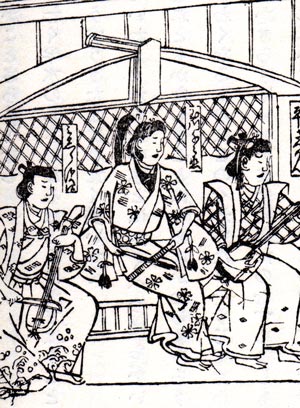| TAMAGAWA SENNOJď I |
|
Stage name:
Line number: SHODAI (I) Existence: ??? ~ ??? Connection: Disciples: Tamagawa Sennoj˘ II, Tamagawa Sennoj˘ III, Tamagawa Shuzen I, Tamagawa Kasen Career: 1639: the Kamigata actor Tamagawa Sennoj˘ I settled in Edo and performed in the 3rd lunar month at the Nakamuraza. Later on, he went back to Kamigata. 1653: second stay in Edo; Sennoj˘ performed at the Ichimuraza. Summer 1654: Sennoj˘ went back to Ky˘to. Fall 1655: Sennoj˘ broke a bone while performing in Ky˘to. 1661: due to the decline of Kabuki popularity in Ky˘to, a group of actors, including Sennoj˘ and Komai Sh˘zaemon, decided to go to Edo; Sennoj˘ performed for 3 years at the Nakamuraza in the drama "Kawachi-ga-Yoi". He received what must have been a huge salary for his time, one ry˘ a day. 1665: Sennoj˘ performed in Nagoya at the Tachibana no Shibai in the drama "Kawachi-ga-Yoi". 5th lunar month of 1666: Sennoj˘ achieved a big success at the Ichimuraza by performing with Tamon Sh˘zaemon I in the dance "Shinobi Guruma". End of the 1660s: Sennoj˘ retired in Ise, where he most likely died. Comments: "Tamagawa Sennoj˘ I was a 17th century Kamigata actor, who came down to Edo after training and winning fame in Ky˘to. He was a pioneer in the development of the art of the onnagata. He performed in front of Lord Matsudaira Yamato-no-Kami, who wrote in his diary in 1661 that "his beauty is more than my brush can express". He was described as looking like a girl until his death. "Tamagawa Sennoj˘ I was mentioned in the theatre chronicles as an unrivalled onnagata; that he first went on the stage at the age of 14, and both while acting and in private life always wore the flowing robe of a woman. He broke a bone, and afterwards his dancing was less graceful; his audiences never failing in their appreciation of him." (ZoŰ Kincaid in "Kabuki, the Popular Stage of Japan") "Tamagawa Sennoj˘, active between around 1650 and 1670, is one of the actors who is said a founder of onnagata. His charm lay in his beauty and the quality of his voice. In particular, he was known for his performance of the role of the wife in "Kawachi-ga-Yoi", a hit show that is recorded to have run for three years. "Kawachi-ga-Yoi" is a play based on an episode from the Heian period romance, "Tales of Ise". Longing for her husband who has gone off to visit another woman, his wife comes out of the bedroom where she sleeps alone and raises the bamboo blind. Then, she composes a poem of longing for her husband; paraphrased it means, "Tonight when there is a strong wind, the white waves must surely be rising in the offing. My husband must be walking alone now in the dark mountain road of Mount Tatsuta." Her husband, who is checking out the situation from the cover of a brush-wood fence, hears this poem and it restores his feelings for her. They say that the acting of Sennoj˘ in the role of the wife, as he came out from behind the bamboo-blind, was magnificent. Probably, reciting the poem from behind the blind, at first he let only his voice be heard, and then, he revealed his beautiful figure to the spectators. It was a dazzling entrance. Moreover, Tamagawa Sennoj˘ was seeing the feelings of jealousy that were burning repeatedly within the woman. I think he expressed these feelings of jealousy, since in Sennoj˘'s art was the ability to express interior feelings." (Takei Ky˘z˘ in his article "An Acting in Early Kabuki") |
 |
|
Tamagawa Sennoj˘ I (center of the picture) around 1666 The Tamagawa Sennoj˘ line of actors |
|
|
| Contact | Main | Top | Updates | Actors | Plays | Playwrights | Programs | Links | FAQ | Glossary | Chronology | Illustrations | Prints | Characters | Derivatives | Theaters | Coming soon | News |